

Damion Smy
Toyota exporting US-built cars to Japan after Trump criticism
7 Hours Ago
High-spec versions get plenty of bells and whistles but it’s far from the sweetest spot in the current Tucson range.



Quickly see how this car stacks up against its competition. Select any benchmark to see more details.
Where expert car reviews meet expert car buying – CarExpert gives you trusted advice, personalised service and real savings on your next new car.
Surely with 14 different variants in the current Hyundai Tucson range, there’s something for everyone lured by the angular cut of this particular Korean SUV’s jib.
This Tucson Highlander N Line 1.6T AWD petrol consolidates a good many of the Korean makers virtues in one high-grade package.
The last version of this car I reviewed was the Elite 2.0D AWD diesel – A great rig with an exceptional 8.3 overall rating. It’s my kind of Tucson: great engine, compelling package and priced smartly enough, at $45k.

Since then, I’ve also sampled the N Line-fettled Elite oiler ($47k), an even fruitier if pricier proposition surely to steal buyer attention away from rival Kia Sportage GT-Line Diesel that asks more than $52k…
Or spark-ignited flagship reviewed here ought to be more impressive judging by its pricing and promise. Highlander and N Line: hey, what’s not to like?
This will test whether the Tucson breed actually holds onto its value proposition well enough when you loosen the purse strings.
This variant clocks in at $51,400 before on-road costs and was available from the second half of 2021 as one of the latecomers to the current 14-strong range. The price has recently risen by $400, up from its original $51,000 last year.
Adding extra cost-optional paintwork ($595), such as our tester’s N Line-exclusive Crimson Red, brings the on-road outlay to just under $57k.
Of course, if there’s pretty much anything about this spec you don’t like, there’s room for adjustment within range. Want diesel? That’s $2k more. Omitting N Line? That saves a grand (in Highlander spec). Want to downgrade to Elite while keeping petrol and N Line spec, that’ll be six-grand thriftier – you get the picture. Something for every taste then.
It’s a bit pricier than its logical rival from corporate cousin Kia and its Sportage GT-Line 1.6T AWD ($49,370) and competes with the likes of the Ford Escape Vignale AWD ($50,090), Honda CR-V VTi LX AWD ($53,200), Mazda CX-5 Akera 2.5T AWD ($53,380), Mitsubishi Outlander Exceed Tourer ($50,990), Toyota RAV4 Edge ($49,820 for the petrol or $52,320 for the hybrid) and Volkswagen Tiguan 162TSI R-Line ($55,990).


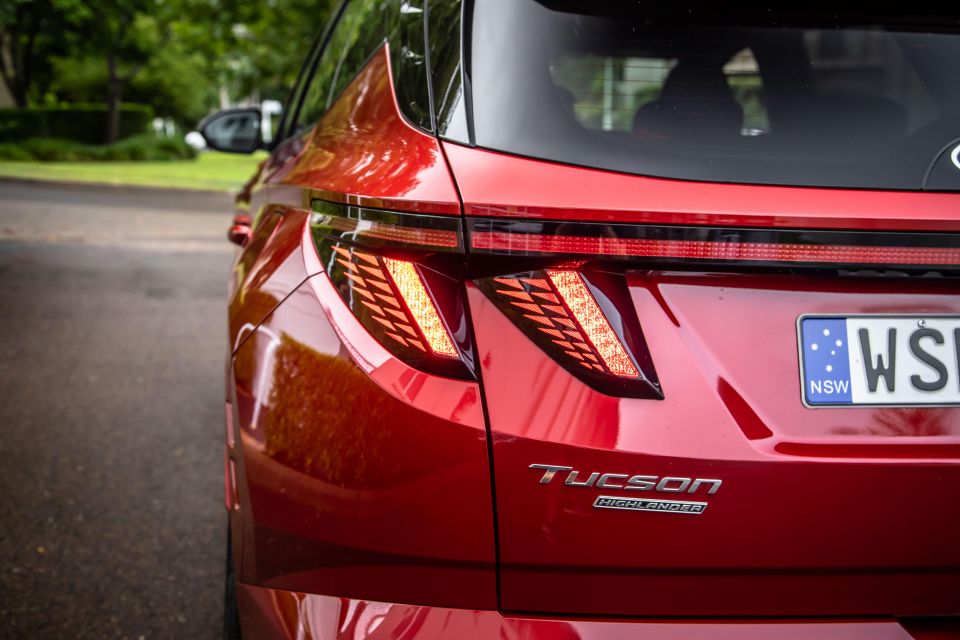
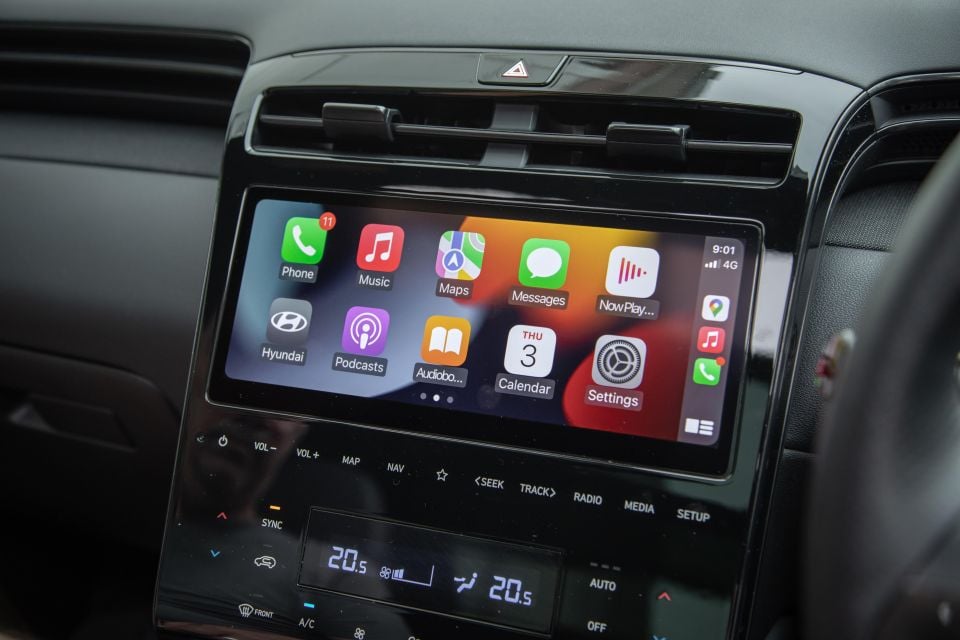
Buy your new car without the stress. It's fast, simple and completely free.

Great service from Travis and team, second time I have used this business would not hesitate to recommend them to anyone
Craig C.
Purchased a Ford Ranger in Sunshine Coast, QLD
CarExpert helped Craig save thousands on his Ford Ranger, now let us save you on your next new car.
Find a dealTucson Highlander highlights:

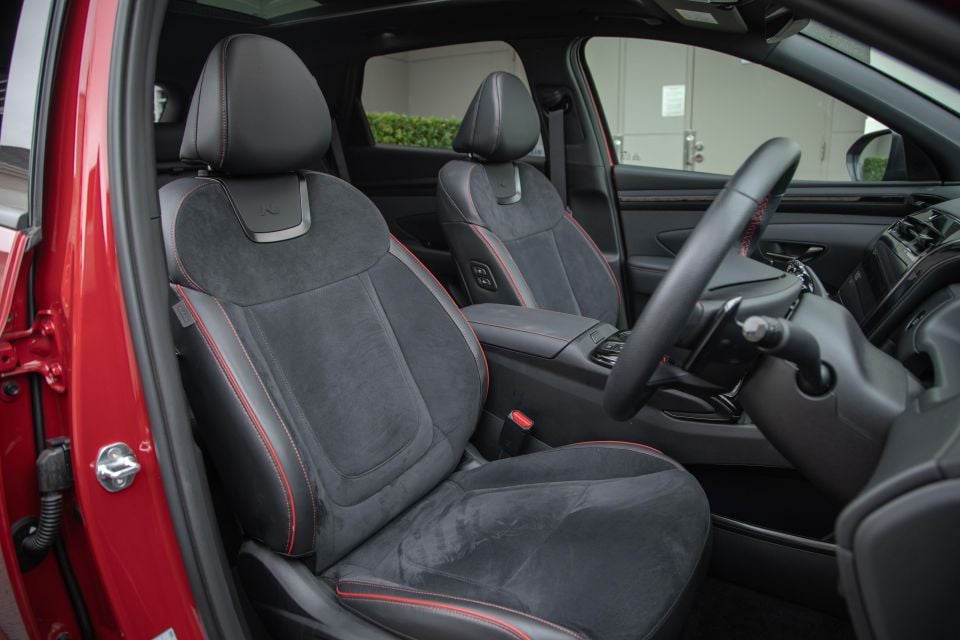


The N Line Package ($1000 for Highlander) adds:
Opting for the N Line package on lower grade base and Elite variants adds larger 19-inch wheels, 10.25-inch digital driver’s instrumentation and LED exterior lighting to the bundle already fitted to the Highlander grade. Thus, the N Line options gets pricier as an add-on the further down the range you look.
A full-sized spare wheel is fitted as standard.

The Tucson line-up wears a five-star ANCAP safety rating issued for all versions from its May 2021 debut.
Adult and child occupant protection was 86 and 87 per cent respectively, while vulnerable road user was 66 per cent and safety assistance scored 70 per cent.
All models feature:
As the flagship, the Highlander grade adds standard features such as LED headlights and taillights, Blind Spot View Monitor (a nifty camera/display-based in-dash blind-spot monitor system) and formally adds reverse AEB, though it will autonomously brake if it senses a potential rear-cross traffic collision.
The blind-spot detection system will also intervene with steering assistance to avoid collisions with adjacent vehicles, while a Rear Occupant Alert Advanced system monitors the second row after the engine has shut down and the doors are locked, triggering an audible warning if movement is detected. This is a great potentially life-saving feature.

We’ve raved about the core interior design in Tucson reviews past, praising it for its modern freshness, intuitive layout and presentation. Combining the Highlander window dressing and features with the sporty N Line look – mostly in the colour theme and leather/suede seating – brings a nice sense of occasion.
I might have even intimated the Highlander N Line might “nudge stablemate Genesis for slickness” in my last Tucson review. Well, it’s good, but…
The good stuff starts with the seating. As a sucker for suede, be it real or fake, I’m drawn to the velvety goodness and the bucket contours do fit the sporty brief for lateral support. One small gripe is that they lack a little give necessary for proper long-haul comfort – Electric lumbar adjustment is handy in helping dial in the right level of support.


The impact of Tucson’s adventurous design – such as Hyundai’s new-look steering wheel – is quite colour dependent. As fetching and racy as the contrasting black/grey/red theme appears, it does mask some of the core styling, robbing it of impact. That’s more an observation than criticism, though lighter and more vibrant colours available elsewhere in its range do the Tucson cabin more justice.
The 10.25-inch driver’s screen, too, is a mixed bag. It floats like an afterthought in the dash fascia and I’m no fan of its default ‘silver dial’ skin – a stock in trade appearance found even in the i20 N. As much as the Blind Spot Monitor system means well, it just doesn’t have a clarity (or processing power) to offer much improvement over the good old-fashioned wing-mirrors they’re attempting to substitute for.
The similarly-sized infotainment screen is better integrated. It’s been rolled out comprehensively throughout Hyundai’s and Kia’s stables and reviewed so extensively now that there’s not much this review can add. It’s clean and colourful, navigation is decent, Bluetooth is well sorted and you get an inductive phone charging pad – angled away from view in the central stack slot, even though Apple and Android connectivity is wired.


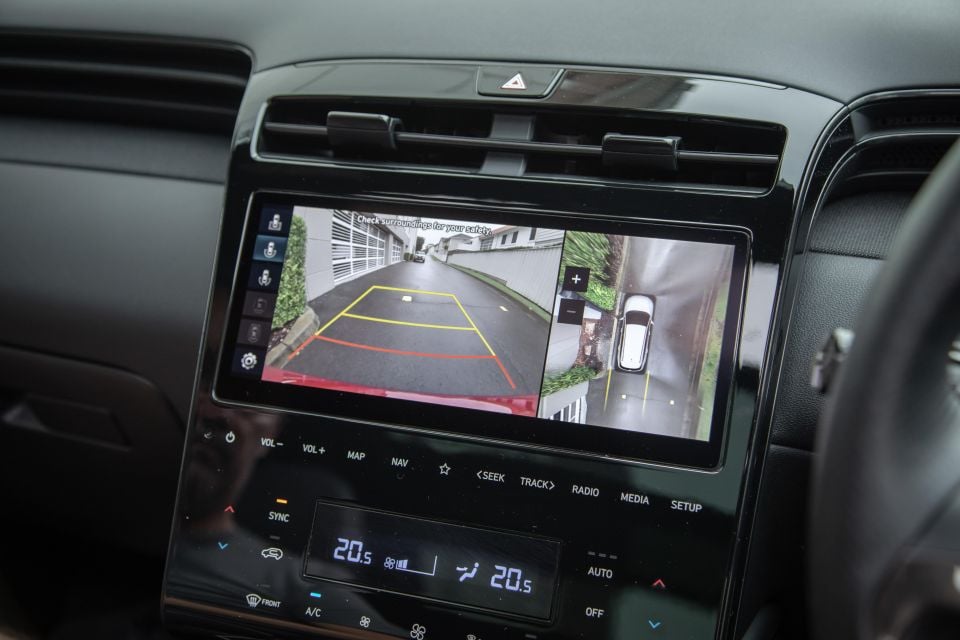

The dual-arc dash effect is still very fetching but the premium feeling the cabin ambience attempts is hampered on two fronts.
Firstly, there’s a little too much cheap-looking plastic in your direct line of sight: the sort of stuff perfectly acceptable in affordable versions is out of place in Highlander grade. Secondly, there’s an awful lot of piano black and clear glassy surfaces (for our well-used press vehicle of around 9000km) and they reveal many scratches and tarnishes.
The Highlander N Line is very nice inside. It’s good, but lots of small things rob it of genuine flagship vibe and it’s a fair way behind the plushness and richness demonstrated in the Genesis GV70 I drove just prior to my Tucson custodianship.
That said, it feels solidly built and the switches and buttons have a quality feel. USB-A ports, a 12-volt outlet and dual cupholders are all logically situated, while storage remains useable, if spatially modest. The Multi-Air climate control mode that diffuses the air via various cabin vents rather than blasting air from the most conspicuous outlets is a good feature too.
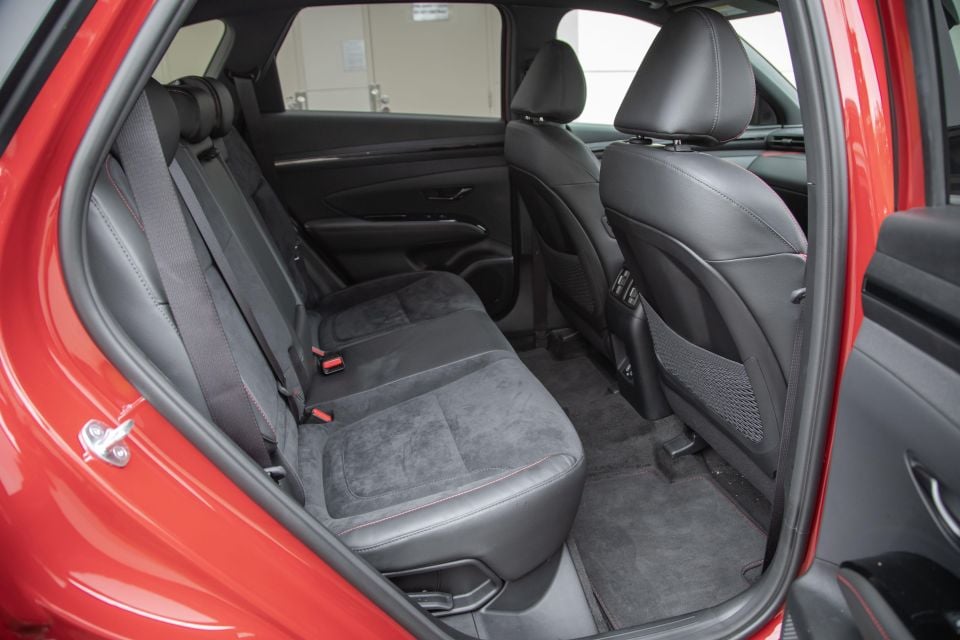

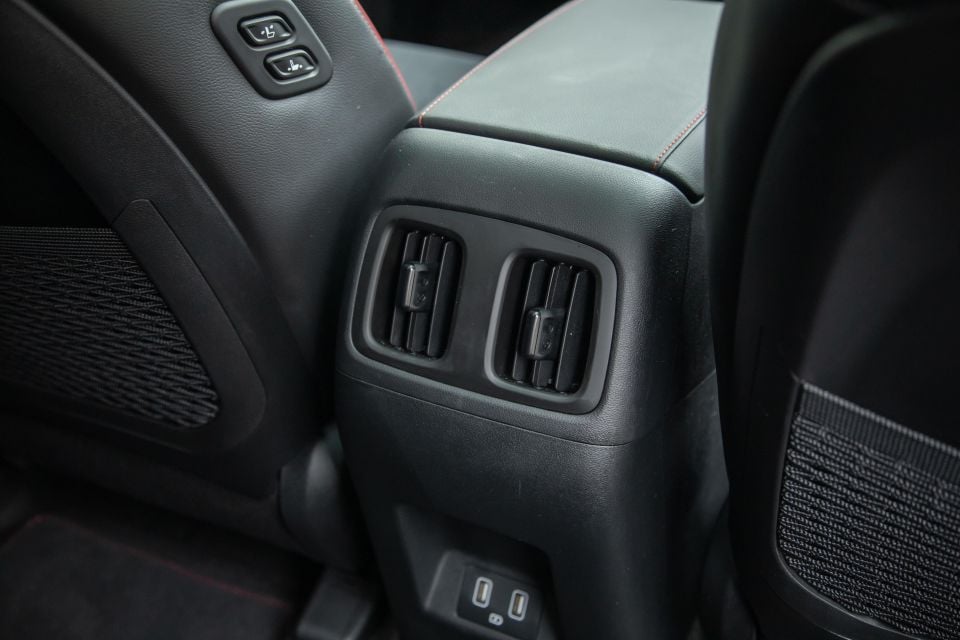

We’ve heaped praise on Tucson’s rear passenger space and it’s no different here. The legroom is very generous and there’s a nice airiness in row two, offering fine four-adult occupancy.
Rear air vents, dual USB-A ports, a fold-down armrest and bottle holders in the doors, ISOFIX mounts in the outboard locations and top-tether points helped achieve a very family friendly fit-out.
Like the rest of the Tucson range the Highlander fits a full-sized spare under the floor while still offering an impressive 539 litres of luggage space. Dropping the 40:60-split-fold seating liberates a fulsome 1860 litres via a reasonably flat load area.

The Tucson Highlander N Line is offered with either a 1.6-litre turbocharged petrol four outputting 132kW and 265Nm or a 2.0-litre common-rail turbodiesel four with 137kW and a lusty 416Nm.
No prizes for guessing which one Hyundai positions as the more premium offering, the oiler, as outlined above, commanding a two-grand upcharge in the top dog version.
The petrol engine, as tested here, is backed by a seven-speed dual-clutch automatic. Opting for the diesel alternative brings an eight-speed torque-converter automatic. Both are on-demand all-wheel drive.

There’s not a huge disparity in fuel consumption. While the more frugal diesel brings a 6.3L/100km combined consumption claim, the turbo petrol is an impressive 7.6L/100km on paper.
On test, it returned nine around town, due to the sort of driving style the powertrain tends to favour (more below). It settled into more frugal figures – six and sevens – during long motorway stints.
What you miss out on in petrol form, outside of better economy and robust torque, is the Multi-Terrain Mode exclusive to diesel version. It introduces Snow, Mud and Sand calibrations for the all-wheel-drive system. Included for both engine types; however, is a suite of selectable drive modes that includes (driver-adaptive) Smart, Eco, Normal and Sport selection.

The Tucson, as a breed, offers a fine on-road experience that’s more mature and generally more refined than the crop that came before it. It’s also quickly asserted itself as a range of two halves: the diesel stuff is great, whereas the petrol versions – be it base the 2.0-litre front-drivers or 1.6 turbo AWDs – aren’t quite so good.
The turbo engine itself is decent enough. On the boil, there’s ample poke, even for a fully-loaded mid-sized SUV, but on balance, it’s perhaps not as ideally matched as it might otherwise be in small, lighter hatchback. Torque is ample, it’s just that in doing its business from standstill at idle, the powertrain just isn’t happy. At least, not without engaging Sport mode.
There’s hesitation off the line, followed by a sharp take-up that’s tough to tame without calculated throttle input. In Smart, Eco or Normal drive modes – take your pick – there’s too much ‘lightswitch-like’ effect in its responses.

It’s easy to blame the dual-clutch as the culprit but part of it is the inherent character of the hardware. Some of it seems related to how it has been calibrated, seemingly to service optimum efficiency. Whatever the case, it really throws a wet blanket over what’s otherwise a well-rounded and much better sorted on-road experience.
The 1.6T powertrain is not nearly as good as the 2.0L diesel. For its part, the oiler’s fatter, more easily accessible torque is married much more happily to the good old-fashioned and vastly more resolved torque converter auto. It’s smoother, more responsive and much more linear. No matter how you cut it, the diesel fits the luxury Highlander better, and the sporty N Line more confidently.
So foisting the underachieving turbo petrol into a Tucson equipped with luxo-sportiness is not an ideal combination. It lacks convincing synergy. Besides, for a ‘sporty’ car, the forced four-cylinder lacks anything like a sporting character when it comes to its sound.
Much like the Elite diesel, the ride and handling balance is middling and nicely struck. I thought the 19-inch wheels – the largest in range – do add a slight edge to compliance. It’s a little more jarring, and a bit fussier across smaller road imperfections than is ideal.

Where expert car reviews meet expert car buying – CarExpert gives you trusted advice, personalised service and real savings on your next new car.
Otherwise it’s a well-sorted chassis with ample corner-carving capability across a twisty backroad if you’re so inclined. But given the N Line version (for its admittedly modest upcharge) doesn’t alter suspension tuning or enhance the way the Tucson steers or stops, there’s little in the way of encouragement to push on beyond balanced, normal driving behaviour.
That said, the ride and handling balance is nicely struck and noise, be it from the tyres, suspension or wind, is suppressed well. There’s a certain premium manner that perhaps is the highlight of its on-road character. The steering, outside of Sport mode, is light and direct.
The Tucson is easy to punt around town thanks to its easy-to-judge dimensions and tight turning circle. Parking is a breeze, provided you’re measured on the throttle of course, and it makes for a fine grocery getter or bus for the school run.
One constant annoyance; though, is the arm-wrestling lane-keeping and lane-following smarts. Just why it plies so much corrective torque through the steering wheel or why it takes an overly distracting moment of button prodding to disengage remains a headscratcher.

The Tucson range is covered by Hyundai’s five-year, unlimited-kilometre warranty.
The bad news is that the 1.6T demands servicing every 12 months or 10,000kms, not the longer 15,000km intervals of 2.0-litre petrol or diesel versions.
Hyundai offers standard plan packages costing $957 (three years/30,000kms), $1276 (four years/40,000kms) and $1595 (five years/50,000kms) upfront, the latter working out to $319 per year.

There’s quite a lot to like about the flagship Tucson, its lengthy list of standard features being the clear highlight.
At a mere grand extra, the N Line package looks to be good value, even if for the lush suede-like seat trim. It’s unsurprising Hyundai forecasts half of Tucsons sold will be fitted with N Line gear.
It’s just that the powertrain lets the team down when it comes to driveability. Indeed, some buyers will only opt for petrol power, but that doesn’t change the fact that, in every way, the diesel engine and its associated powertrain is superior. It’s gutsier and easier to live with, excluding perhaps, the greasy business of filling up at the bowser.
The Elite diesel with N Line package is much closer to Tucson in its finest form. It’s a more balanced formulation, offers most of the properly desirable goodies as our top dog test subject here, is a measurably better drive, and saves you around four grand off the showroom floor.

Click the images for the full gallery
Where expert car reviews meet expert car buying – CarExpert gives you trusted advice, personalised service and real savings on your next new car.


Damion Smy
7 Hours Ago


CarExpert.com.au
23 Hours Ago


James Wong
1 Day Ago


William Stopford
1 Day Ago


William Stopford
11 Days Ago


Gautam Sharma
12 Days Ago